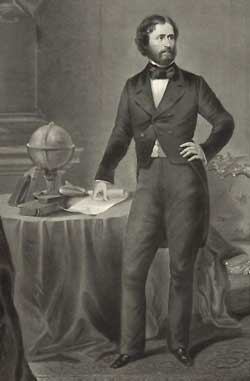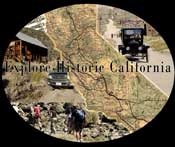By the time John C. Fremont made his decision to cross the
Sierra Nevada mountains to the Sacramento Valley instead of
heading back east as originally planned, his party was beginning
to look a bit ragged.
 |
|
Portrait of John C.
Fremont, circa 1859.
(Library of Congress
collection) |
While the expedition had gone relatively smoothly as these
things go, tough terrain, the onset of winter weather, and
meager provisions had begun to take its course on both the
animals and the men. The jaunt from Fort Vancouver to an open
area near the present day site of the town of Reno had already
cost the party 37 of the original 104 horses and mules.
Discouraging Indian warnings of rocky and snowy precipices
failed to convince Fremont that his decision to forge ahead was
not a good one. The dilapidation of animals, deteriorating
horseshoes with no means to replace them, and the anticipation
of a mere seventy mile crossing to Sutter’s Fort for supplies,
looked more palatable to the entire party. In lighter weather,
the journey would take no more than 6-7 days.
February 1, 1844, the ascent into the high country was to
begin. Heavy falling snow mounted in the meadow where the men
were encamped. Complaints of lack of substantial food in their
bellies could be heard. The stock could not be spared until they
were so worn down they could not travel and there was no game in
sight anywhere. Two camp dogs and a stray picked up in Bear
Valley proved to be in good shape with meat on them. Fremont
gave approval for a dog feast. After the slaughter of one fat
dog, the Washoe Indians showed up with a couple of snowshoe
rabbits, which were purchased from them to make a fine meal.
The following day arrived with frosty but clear air and a
view of snow covered peaks towering six or seven thousand feet
above revealed itself between rolling clouds. The Indian guide
shook his head and was quick to point out icy pinnacles that
shot up into the sky. Silently the men broke camp, and crossed a
heavy iced river, as their journey into the Sierra Nevadas
commenced.
Quickly, the trek through the snow deepened as the men made
their ascent. A party of ten of them mounted the ablest of
horses, taking turns opening the road on foot or horseback until
exhaustion set in. In spite of rough going, sixteen miles were
traversed this day. By the third day the going slowed to a mere
seven miles, as they continued along steep hillsides and over
spurs where good quality grass was exposed thanks to wind and
sun. Upon reaching a stream at another basin, no more grass was
found, and the rest of the day was spent beating down a road
within a foot of a hill that was only a mile or two distant.
Indians joined them on snow shoes during the day.
On February 4, Fremont and several of his men went on to
break the road ahead. The hollow was abandoned for the steep
mountainside, snow covered with crusty ice. Slowly they cut a
footing, trampling a trail for the animals. Still, an
occasional horse or mule would plunge outside this trail and
slide along the field to the bottom a hundred yards below.
That night, after laborious attempts to force a road, the
best horses gave out, and brought everything to a stand still.
The Indian guide told them they were just beginning to reach the
deep snows. That evening, after the group with only the best
horses succeeding to reach the hill, an unsheltered camp was set
up, with a large fire around a the trunk of a huge pine to warm
them. The men covered the snow with small boughs, and spread
their blankets for a clear but strong winded night with
temperatures down to 10 degrees. Two Indians joined them here,
one an old man warning, “Rock upon rock- rock upon rock-snow
upon snow- snow upon snow.”
Once again, Fremont ignored the treacherous warnings, and
declined an offer to be shown an easier more southerly route.
His expedition continued on, shoveling snow, and beating trails
so they would be hard enough to hold the weight of the horses
and mules. Snow shoes and sledges were built to make
transporting themselves, and their baggage easier. This also
allowed the animals to conserve their energy for their own trek
over the newly made paths. Fatigue, lack of food and salt in the
men’s diet, combined with continued frigid temperatures took
toll daily.
Upon reaching camp on February 6, a man by the name of
Fallon was exhausted and showing signs of frost bite in his
feet. A fire was built in the trunk of a dry old cedar, and Mr.
Fitzpatrick stayed with him until his clothes dried and he could
move on. Meanwhile, another twenty miles of hard travel faced
everyone until nightfall hit and camp was made.
Two days later, in extreme temperatures dipping down to 3
degrees below zero before the sun rose, two more men showed
signs of extreme hunger and fatigue, after being sent ahead to
ascend a higher peak and check on conditions. As the sleighs
arrived with supplies, and more snow-clouds carried the threat
of yet another storm, Fremont gave the men tea and sugar. By
February 9, the rest of the party began showing signs of
weakness from lack of salt and food. More trees were set to
fire, and snow holes dug to provide camp.
High winds, and the glare of snow plagued travels as
elevations of eight thousand and fifty feet were reached, with
more peaks remaining to be ascended. Black silk handkerchiefs
were donned as veils to protect the eyes. The situation was
described as tiresome and dreary, by February 11, in Fremont’s
memoirs. The news from Mr. Fitzpatrick left behind with the
mules and horses didn’t sound much more promising, when he sent
a message that the half hidden trail was too slight to support
them, and they had broken through plunging about or lying in
half-buried snow. Fremont sent orders to send the animals to
pasture while mauls and shovels were made to strengthen the
trail and try again.
Two more days passed, with hard labor on the road, and a
visit from not only Mr. Fitzpatrick reporting that all was going
well on his end, but a party of Indians passed as well. The
Indians were on their way to the western side of the mountain
after fish, indicating salmon coming up streams, and food in the
party’s future. That evening, the meat train did not arrive, and
orders were given to kill and prepare the favorite dog Tlamath,
for dinner. The dog was prepared Indian style, with hair
scorched off; skin washed with soap and snow, and then cut in
pieces which was laid into the snow. Not long after, the sleigh
full of meat finally arrived, and an extraordinary dinner of
pea-soup, mule, and dog was had by all.
St. Valentine’s Day arrived and Fremont took his man Preuss
with him for a hike just north of camp. The Peak, now called Red
Lake Peak, provided a view of a magnificent lake to the north.
The lake was judged to be about fifteen miles in length,
completely surrounded by mountains, with no apparent outlet. The
lake had been described to them earlier by the Paiutes at
Pyramid Lake. Fremont and Preuss were the first white men to see
this lake, which would eventually be known as Lake Tahoe.
Fremont reported successfully getting the animals safely to
the first grassy hill on February 16. He chose one of his men by
the name of Jacob to accompany him on an expedition beyond the
mountain. As they traveled crests of narrow ridges, extending
down from the mountain towards the valley, the snow was fast
melting away. Open spots of good grass was spotted. As the sun
went down icy spots were discovered in a deep hollow; and as
they descended the mountain, near the head waters of a little
creek appeared to be a good spot to spend the night. The sound
of wild animals, including a flock of wild geese, accompanied
the clear long night bringing pleasure to their senses and the
hope that game would be in abundance and relieve their near
depleted supplies.
 |
|
Map of an exploring
expedition to the Rocky Mountains in the year 1842 and
to Oregon & North California in the years 1843-44 / by
Brevet Capt. J.C. Frémont of the Corps of Topographical
Engineers; lith. by E. Weber Co., Baltimore, Md.
(Library of Congress,
Geography and Map Division) |
As morning came, they followed the creek, relieved to hear
the sound of rushing water below the icy surface. The ice broke
through as they walked through after a few miles. Here they
halted to make a fire and dry their clothes before continuing on
another couple of miles where they could walk laboriously
without snowshoes. The headwaters of this creek proved to travel
west toward the Pacific, and Fremont was convinced that he had
struck a stream that would lead them to their destination in
Sacramento Valley.
Fremont and Jacob climbed to the top of the ridge using all
their strength and determination, until they reached the base
camp at dark. The site of the remaining fifty-seven animals
grazing at a grassy hill near the camp was especially pleasing.
This and the availability of an abundance of salt and pine nuts
which had been traded by local Indians proved exceedingly good
news for hungry and weak men.
The sun warmed, and the snow continued to melt, making
trail building to the pass easier so remaining baggage could be
brought up from a lower camp. By February 20, the expedition was
moving out of snow holes, heading up the canyon and climbing
towards the mountain summit. That night they camped with all of
the animals and all of the camp material on the summit dubbed
“Snowy Mountain” by Fremont. The pass was just south of present
Kit Carson Pass. The following day, February 21, the Fremont
expedition considered themselves “victorious over the mountain,
with only a descent before us, and the valley under our eyes, we
felt strong hope that we should force our way down.” Ahead,
however, “lay deep fields of snow and a large intervening space
of rough-looking mountains” which they had yet to accomplish.
To be continued…..
